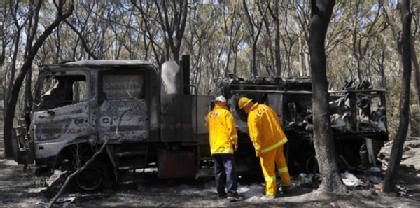Victorian Bushfires: CFA ill-prepared and reliant on obsolete firefighting technologies
 The charred shell of a $350,000 CFA truck near Belgrave Heights during the 2009 Victorian Bushfires. The tanker was able to protect three firefighters from an out-of-control bushfire as it burnt over them. But in 1998, a burn-over incident during a bushfire at Linton, near Ballarat, killing five CFA volunteers. Photo: Craig Abraham [courtesy: The Age 25-Feb-09]
The charred shell of a $350,000 CFA truck near Belgrave Heights during the 2009 Victorian Bushfires. The tanker was able to protect three firefighters from an out-of-control bushfire as it burnt over them. But in 1998, a burn-over incident during a bushfire at Linton, near Ballarat, killing five CFA volunteers. Photo: Craig Abraham [courtesy: The Age 25-Feb-09]
A report by ABC journalist, Jane Cowan, 1-Jul-09, 'Bushfire lawyers blast CFA's Rees' states that lawyers assisting Brumby's Royal Commission into the 2009 Victorian Bushfires have in an interim report concluded that the Victorian Country Fire Authority (CFA) was ill-prepared for Black Saturday. The lawyers have criticised CFA chief fire officer, Russell Rees, as having been "divorced from fundamental aspects of the responsibilities" as chief officer, 'including the provision of public warnings and the protection of life and assert that Mr Rees "should have made himself aware of predictions forecasting the path of the fires."
Criticism has also been made about the reliance by the CFA on obsolete fire fighting technologies. Bushfire consultant assisting the Commission, Tony Cutcliffe, has stated "We still have people running these organisations who are predominantly devoted to a firefighting technology that is no longer in vogue let alone being attuned to the needs of behavioural management and leadership."
What is most disturbing of all is that the CFA looks to continue business as usual. The CFA says it has full confidence in Mr Rees and expects him to be at the helm again this summer. Mr Cutcliffe has expressed his concerns that 'whatever changes are made, as it stands now the same management team that presided over the system which failed to cope on Black Saturday will be required to implement the new regime.'
If the calamity of what happened to Victoria last summer won't force an overhaul of firefighting in Australia, what will?
The CFA's old-school firefighting culture dies hard:
* The CFA remains an emergency response organisation almost totally dependent on a disparate weekend volunteer base (not the fault of the volunteers who are effectively unpaid public servants);
* The CFA's bushfire notification system is wholly reliant on public calls to 000;
* The CFA's fire fighting response system is centred around urban fire trucks that cannot access remote ignitions and so must wait until accessible from a roadside, when the fire is by then often out of control. Taking fire trucks into the bush to fight fires is deadly as the above photo shows;
* The CFA remains a public authority with carte blanche to allow and deliberately cause immense irreversible damage to Victoria's remaining ecolgical habitat, yet with no ecological expertise in its management or ranks;
* The CFA is grossly underfunded by state and federal governments.
Some questions:
1. Given that unprecedented extreme weather was forecast and known to the CFA, what commensurate planning, preparation and response did the CFA deploy and when?
2. What improvements in fire fighting practices have been implemented by the CFA since the 1983 Ash Wednesday fires to avoid a repeat?
3. Where are the statistics showing the fire fighting performance in respect to each reported ignition, namely:
a. Elapsed time from estimated ignition time to detection time (CFA becoming aware of ignition)
b. Elapsed time from detection time and on site response time (CFA arriving at the fire site/front with fire fighting equipment)
c. Elapsed time from response time to suppression time (fire extinguished by CFA)
These are the three core fire fighting performance metrics.
The Bushfire Royal Commission is following its terms of reference in assessing the specific facts and specific causes of the fires and logically as expected is starting to lay blame. What's the bet many findings are similar to those of previous bushfire investigations? If the Royal Commission finds that the current system and structure of Victoria's (read Australia's) volunteer firefighting organisation was at fault, then this is a constructive outcome. Only at such a legal level will change be forced on the system and culture. Previous internal debrief meetings and investigations (e.g. the 2003 Esplin Enquiry) have managed to have lessons from bushfire disasters ignored and fire fighting practices remain relatively unchanged. If fire fighting is becoming more effective then how can such tragedies be continuing and growing in scale? How much more 20-20 highsight is needed by the so-called 'experienced' fire fighting leadership before we can observe tangible improvements in fire fighting performance?
Same old same old. Given the dire inadequacies of this organisation, the culture has forced to become one of absolute defeatism - the only way it believes it can deal with bushfires is to slash and burn as much of the natural burnable landscape as possible, so that there is nothing left to burn. It's as crackbrained as backburning through Belgrave Heights in order to save Belgrave.
Change cannot be brought to the CFA within the CFA. Change must come from Brumby and Rudd.

Recent comments